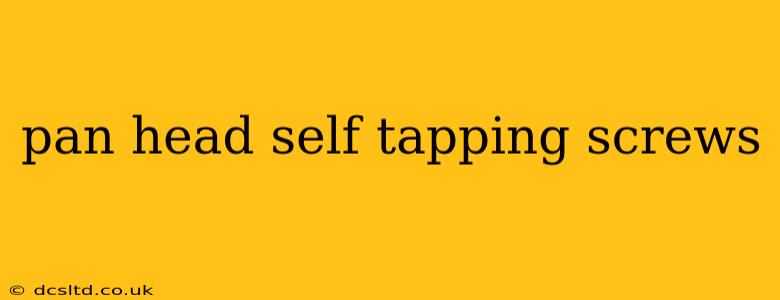Pan head self-tapping screws are a common type of fastener used in a wide range of applications, from assembling furniture to securing metal components. Their unique design allows them to create their own threads as they are driven into a material, eliminating the need for pre-drilling in many cases. This guide will delve into the specifics of these versatile screws, answering common questions and exploring their advantages and disadvantages.
What are Pan Head Self-Tapping Screws?
Pan head self-tapping screws are characterized by their flat, slightly countersunk head and their ability to form threads in the material they are screwed into. This "self-tapping" feature makes them incredibly convenient for many DIY and industrial projects. The pan head design allows for a flush or near-flush finish, creating a clean, aesthetically pleasing look. The screws are available in various materials, sizes, and thread types, catering to diverse applications and material requirements.
What are the different types of Pan Head Self-Tapping Screws?
There's a surprising variety within the pan head self-tapping screw family. Understanding these variations is crucial for selecting the right screw for your project. Key differentiators include:
- Material: Common materials include steel (often zinc-plated for corrosion resistance), stainless steel (for superior corrosion resistance), and brass (for applications requiring non-ferrous material).
- Thread Type: Different thread types, such as coarse or fine threads, influence the holding power and the ease of driving. Coarse threads are generally used for softer materials, while fine threads are better suited for harder materials.
- Point Type: The point type also matters. Some screws have sharp points for easier penetration, while others have blunt points to minimize damage to the material.
- Drive Type: These screws are typically available with Phillips, slotted, or other drive types, ensuring compatibility with various screwdrivers.
What materials can Pan Head Self-Tapping Screws be used with?
Pan head self-tapping screws are versatile and can be used with a range of materials, including:
- Wood: They are commonly used for assembling wooden furniture, decks, and other wood structures.
- Metal: Certain types are designed for use with sheet metal, offering a secure fastening solution.
- Plastics: While care needs to be taken to avoid stripping, they can be used to secure plastics in many instances.
However, it's crucial to choose the right type of screw for the material. Using the wrong screw can lead to stripped threads or poor holding power. Always consult the manufacturer's specifications to ensure compatibility.
What are the advantages of using Pan Head Self-Tapping Screws?
Several advantages make pan head self-tapping screws a popular choice:
- Ease of Installation: The self-tapping feature simplifies installation, often eliminating the need for pre-drilling. This speeds up the assembly process significantly.
- Cost-Effectiveness: The reduced need for pre-drilling lowers labor costs and overall project expenses.
- Strong Hold: Properly selected screws provide a strong and reliable hold in the intended material.
- Aesthetics: The pan head's low profile creates a clean and professional finish.
What are the disadvantages of using Pan Head Self-Tapping Screws?
Despite their advantages, there are potential downsides to consider:
- Material Damage: In some materials, particularly softer woods or plastics, the self-tapping action can cause splitting or cracking if not handled carefully.
- Thread Stripping: Over-tightening or using the wrong type of screw can lead to stripped threads, rendering the fastener useless.
- Limited Applications: They may not be suitable for all materials or applications, requiring the use of alternative fasteners.
How do I choose the right size Pan Head Self-Tapping Screw?
Choosing the correct size is critical for optimal performance. Consider these factors:
- Material Thickness: The screw length should be sufficient to penetrate the material and provide adequate thread engagement.
- Material Type: Different materials require different screw sizes and thread types for optimal holding power.
- Application: The intended application will dictate the necessary screw size and strength.
Are Pan Head Self-Tapping Screws suitable for all applications?
No, they are not universally suitable. While extremely versatile, they're not ideal for all materials or situations. High-strength applications or materials requiring extreme holding power may necessitate alternative fasteners like machine screws and nuts.
What is the difference between a self-tapping screw and a self-drilling screw?
While both create their own threads, self-tapping screws typically require a pilot hole, especially in harder materials, whereas self-drilling screws incorporate a drill point at the tip, eliminating the need for pre-drilling in many cases. Self-drilling screws are generally designed for thicker materials.
This comprehensive guide provides a solid foundation for understanding pan head self-tapping screws. Remember that proper selection and installation are key to achieving optimal performance and avoiding potential problems. Always consult the manufacturer's instructions for specific recommendations based on your chosen screw and application.
